Substrates for Caudates II: Terrestrial substrates
By Johnny O. Farnen
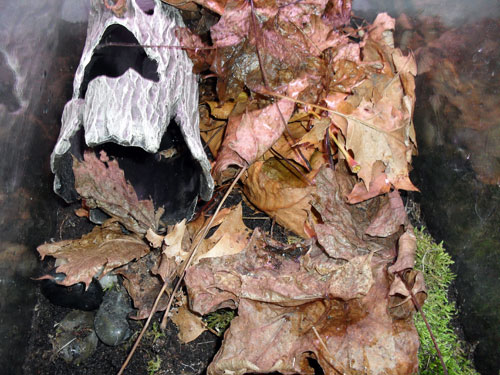
A mixed leaf litter substrate with moss and leaves. Photo: Johnny Farnen, 2009.
A number of factors should go into your decision about what kind of substrate to use for housing terrestrial newts and salamanders. These factors include:
- the adult size of the animals,
- the types of food to be offered,
- the wild environment of the species,
- the degree of moisture retention needed,
- the methods of sanitation to be used,
- the gastrointestinal impaction risk of the substrate.
Moisture retention is a big factor; salamanders do not drink water, but instead depend on the humidity of the soil to maintain their hydration. Sanitation comes into play both in ease of cleaning the enclosure and preventing anaerobic decay of the substrate. Risk of gastrointestinal impaction is lower for terrestrial species than for aquatic species, yet the size of the substrate particles must still be taken into account to minimize risks from possible ingestion.
Basic Terrestrial Substrates
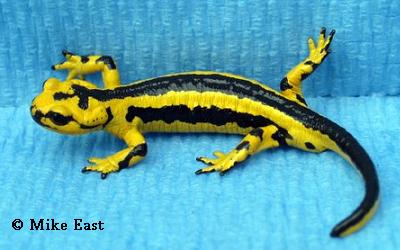
Some experienced breeders keep their salamanders on paper towel substrate. Photo: Mike East.
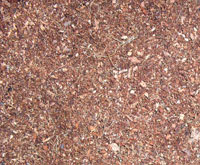
Coir, commonly known as coconut fiber, is an excellent substrate for most terrestrial caudates. Photo: Johnny Farnen, 2009.
Paper towels moistened with dechlorinated water make a good temporary substrate for sick or quarantined animals. The ease of keeping such a substrate clean is beneficial. However, the need to change the toweling every day make it undesirable to many keepers. Also, some keepers recommend against long-term use, as paper products may contain chemicals that can have adverse health effects. On the other hand, some breeders and zoos have housed amphibians on paper towels, both unbleached and bleached, for long periods of time without obvious detrimental effects.
Coir, or coconut husk fiber, is very popular with amphibian keepers. It comes in a few different forms, from finely ground sand-like particles (often sold compressed into a "brick") to coarse mulch-like pieces. Coir is relatively inexpensive and easy to keep clean. Its hygroscopic (water-absorptive) properties are excellent, though the rate of evaporation is faster than bark products. Use of the finely-ground type minimizes impaction risks, while providing a very easy-to-dig substrate for tunneling and burrowing caudates. One disadvantage to coir is that if kept too wet, it quickly fouls. Proper ventilation and a drainage layer are highly recommended when using pure coir as a substrate. Another disadvantage for some amphibians is that it tends to stick to their skin; this problem is greatly reduced by mixing it with other substrates.
Various sheet mosses are commonly used with success. Live moss of temperate or semi-tropical origin is generally easiest to keep. Dead moss products should be used with caution or avoided altogether. Some commercial moss products have been dyed with copper based dyes, which may be toxic. Some of these dyed products are even sold as live moss! Live or dead, mosses are viable substrates, as they hold moisture well and have little or no impaction risk. The downsides to moss substrates are they can be hard to keep clean and they can easily foul under certain conditions. Spot cleaning is nearly impossible without destroying the moss bed. Some dead moss products can also cause low substrate pH issues.
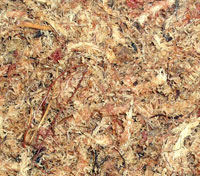
Sphagnum moss should be used with caution due to the risk of low pH. Photo: Johnny Farnen, 2009.
Sphagnum peat moss is generally not a recommended substrate for captive caudates. Decaying sphagnum moss has antibacterial and antifungal characteristics that can be desirable in vivaria; however these advantages come at the cost of potentially-dangerous low pH. While some keepers have used peat moss with success, it is important to note that there is batch-to-batch variability in the pH of peat, and there is also wide variation in particular species' tolerance for low-pH environments. Thus, as a general rule, this is a substrate to avoid. See below for more information on pH effects and testing.
"Long Thread" sphagnum moss is used frequently, but should be carefully tested for pH prior to use (see below). It appears that the source of the sphagnum affects how acidic it is. Terrestrial sphagnum seems to have low pH problems, while arboreal sphagnum, the type that grows on tree bark, appears to be less of an issue. When used as the sole substrate, health issues are most often encountered when the sphagnum is kept saturated for long periods of time or exposed to standing water.
Bark substrates are carryovers to vivaria from orchid keepers. Fir bark and cypress bark mulches are readily available at pet stores. Cypress mulch may also be obtained from home improvement stores. Available in many grades, from finely-ground to very coarse, bark substrates have many of the same advantages as coir products. Bark products have good hygroscopic properties. They do not release moisture as well as coir, but are less prone to wet fouling. Thus fouling of the substrate due to moisture content is a rare occurrence. Drainage is very good with the medium and coarse grades, making bark useful in enclosures with water features. With the coarse grades, spot cleaning can be problematic due to the size of the particles. Live foods easily escape into the substrate. The types of bark that are considered safe/unsafe can be found in Wood for Use in Vivaria.
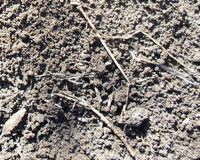
Clean, uncontaminated top soil can be very useful, but the hobbyist should be aware of the risks. Photo: Johnny Farnen, 2009.
Soil substrates of many different types are used with success. Care must be taken in choosing the type and source of soil used. Soils used in vivaria typically come from three common sources: top soil, potting soil, and soil collected outdoors. Note that potting soil and topsoil are NOT the same thing!
Potting soils manufactured for plants are usually not a good choice, as they may contain strong fertilizers, which can be fatal to caudates. Perlite and polystyrene beads are often included to increase drainage and water retention, but these particles pose a dangerous impaction risk. Many commercial potting soils also contain composted manure, which can lead to foul odors and health issues. Potting soil may also contain peat moss, which can cause low-pH issues. Careful research into the specific brand of soil, most often in the form of direct contact with the manufacturer, is the only way to be certain whether a particular potting soil is truly safe to use.
An alternative to potting soil is packaged topsoil. Again, take care to choose a brand that does not contain peat moss or composted manure. It may be helpful to choose a brand that is organic, but this is no guarantee of suitability. Some top soils contain an ingredient list. Beyond that, you may need to buy a bag and examine it closely to get some idea about its composition and properties.
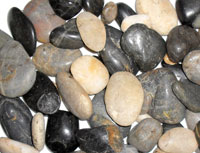
Commonly sold in pet and craft stores, this river rock is suitable as both a substrate and an accent object. Photo: Johnny Farnen, 2009.
Use of soil from a garden or yard is a viable alternative only if it is free from pesticides, herbicides, and fertilizers. Urea, a common fertilizer, can be very harmful to caudates, as they are unable to sense toxic levels in their substrate. If you live near a freeway, airport or non-organic farm, native soil use should be avoided for contamination reasons.
It must be stated that outdoor soils have the potential for introducing parasites, fungi, or other pathogens. However, "live" soil can also be advantageous, as it contains a natural balance of nitrifying bacteria and other beneficial organisms. It may even contain micro-food for your salamander. If the introduction of outdoor life or parasites is of particular concern, dirt can be baked (95°C/200°F for 30 minutes or more) or frozen (<0°C/32°F for 2 weeks or more).
To prevent soil from becoming heavy and compact, it is wise to mix it with coir and a small amount of sand to promote drainage and prevent the soil from becoming heavy and compact. Soil collected outdoors often has drainage and compaction issues, depending on where it was collected. Soils from Mediterranean and desert environments are generally not suitable for use with caudates. Purchasing a soil testing kit from a garden center is a very good idea. A pH test and a lead test are also readily available at many of these stores.
Leaf litter or loam is a viable substrate for many terrestrial caudates. It can only be collected in the field. Leaves can be collected from the surface (the leaf litter layer) down to where it actually has composted into soil (the loam layer). These materials are neutral in pH (usually), easy to clean, and pre-stocked with both beneficial bacteria and live foods. This substrate can be a caudate keeper's best friend, especially when used with a live soil substrate. If the introduction of these naturally-occurring organisms is a concern, the material can be frozen, as described above for soil. Baking is not recommended, due to the potential for scorching.
When collecting leaf litter, avoid areas containing walnut or other toxic trees. In choosing a safe source for leaf litter, refer to Wood for Use in Vivaria. The toxicity listing there applies to leaf litter in most cases.
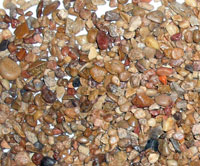
Aquarium gravel is sometimes useful, but caution should be exercized. Photo: Johnny Farnen, 2009.
Leaf litter and loam can be very easily shredded to a fine consistency in a food processor. Make sure to examine the litter thoroughly prior to shredding, as you may have inadvertently captured wild salamanders or other small animals!
Sand and gravel substrates are controversial. The impaction risk and poor moisture retention qualities are major factors. Keeping such substrates clean is particularly a challenge; they are prone to becoming host to anaerobic (swampy) decay. If cleaning is done daily, and water is not permitted to foul in them, these substrates are a viable option for certain species and situations. (see Wright and Whitaker's Amphibian Medicine and Captive Husbandry, pp. 40-42).
Mixed Substrates
Caudate-friendly ABG Mix
- 1 part tree fern fiber
- 2 parts coir
- 1 part play sand
- 1 part fir bark
Leaf Litter Mix
- 4 parts leaf litter
- 2 parts soil
- 1 part play sand
Coir Mix
- 1 brick coir, expanded
- 8 cups top soil
- 4 cups fir bark
Substrate mixes allow the hobbyist to utilize the advantageous properties of multiple basic substrates. Pre-mixed substrates can be purchased at pet shops. Those that are marketed to mimic forest floor types of habitats are generally suitable for terrestrial newts and salamanders. However, these products tend to be expensive.
Homemade mixes are easy to make and much cheaper. While there is no "standard" recipe, the Atlanta Botanical Gardens' substrate mix (ABG mix) is a good starting point. It retains moisture while promoting aeration and drainage. This mix supports the growth of epiphytic plants, yet other types do not thrive well in it. It also is relatively stable for burrowing and tunneling caudates. The original ABG mix developed by Ron Gagliardo consisted of two parts tree fern fiber, one part peat moss, two parts coir, one part activated carbon, and two parts fir bark. Designed for orchids, it quickly became a favorite of dart frog keepers. A caudate friendly version is shown at right. Activated carbon should not be included, as discussed below.
A leaf litter-based mix is relatively inexpensive and extremely versatile. It is a very good option, especially for caudates indigenous to deciduous forests. While recipes vary greatly, the mix shown at right works exceedingly well. Many keepers skip the soil and just use slightly-decayed leaf litter/loam with a small bit of sand added to reduce soil compaction.
While the previous examples are just a sampling of many possibilities, hobbyists should design their mix based on moisture retention, ease of cleaning, and whether live plants and moss are to be used. Addition of soil to the mix will guarantee support for plants and mosses.
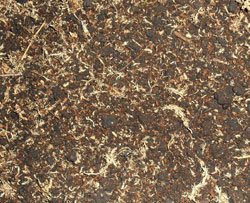
A modified ABG mix made with terrestrial caudates in mind. Photo: Johnny Farnen, 2009.
Tree fern fiber is considered an acceptable component for amphibian substrate mixes. However, it should also be noted that tree fern fiber is often collected from nonrenewable sources. Coir fiber is a suitable replacement that is much more environmentally friendly.
Activated carbon (often mistakenly called charcoal) as a terrarium component is another carryover from orchid terrariums. Its use in vivarium substrate mixes containing live animals is of little or no value. While it does absorb "toxins", think about that for a moment. If proper substrate is installed and maintained, where are the "toxins" coming from? Use to promote drainage can result in problems, as it provides a very nice, clean, non-toxic surface to harbor unhealthy bacteria and fungi. Fir bark, tree fern fiber, cypress mulch, chunked cork bark or coarse-cut coir are better, safer solutions to promote drainage. Activated carbon granules also have a very high gastrointestinal impaction risk in caudates.
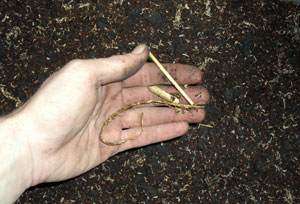
When mixing up substrate, take care to remove large pieces like these, which can be hazardous to your pet. Photo: Johnny Farnen, 2009.
If live plants are to be used in a vivarium, soil that supports plant growth and a drainage layer are highly recommended. The simplest solution to this issue is to keep the plants in small plastic or terra cotta pots, where they will have their own micro-environment. To discourage burrowing caudates from digging in the pots, the base of the plant can be protected with a layer of river rock or slate. The pot itself can be hidden under moss or other substrate. The plants can be moved easily when substrate changes are required (see section below on Maintenance).
pH Testing
The pH of terrestrial substrates is an important issue. There are definitive links to low substrate pH and bloat issues in terrestrial caudates, especially Ambystomids. One should plan a substrate that will mimic the pH preferences of the specific salamander in the wild. If the species' preference is unknown, it is safest to aim for a pH that is near neutral. For testing soil, garden centers sell pH test kits made specifically for soil testing.
A simple pH test, described by Ed Kowalski, can be used to check the safety of mosses or other products. Simply soak the moss overnight in a glass container of distilled water (tap or spring water may skew the results). Be sure that the water is packed with as much moss as can be packed into the water. The next day, strain out the moss and test the water with an aquarium pH test kit. If the pH is below 6.0, avoid using the material.
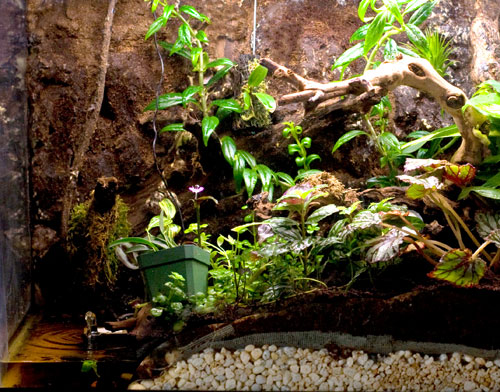
An example of a well-planned, layered substrate incorporating a water feature. Photo: Wesly Carter, 2009.
Drainage
Drainage and aeration are generally not a concern for most terrestrial caudate setups, However, a properly installed drainage layer may help extend the life of your substrate, allow planting of live plants, and help in recovery from overwatering or leaking water features.
The simplest and most basic drainage layer can be achieved by utilizing coarse gravel, leca or hydroton (clay) balls, or lava rock. Typical aquarium gravel is too small. Individual rocks in the drainage layer gravel should be at least 10 mm (roughly 1/3rd of an inch) or larger. A depth of about 25 mm (1 inch) is necessary to provide ample drainage space. Gravel size should be dependent on the size and type of caudate to be housed and can be covered with mesh to keep burrowing caudates out.
Another method is to install a drainage grid to provide a water gap at the bottom of the enclosure, under the substrate. These false bottoms can be achieved in various different ways, ranging from the installation of an under-gravel filter plate designed for aquariums to homemade solutions using plastic egg crate (a material sold for light diffusers).
One often-overlooked aspect of vivarium design is to provide a way to remove excess water from the enclosure without disturbing the substrate. If the stagnant water cannot be removed, this defeats the purpose of having a drainage layer. The simplest way to allow for water removal from the drainage layer is to install a section of small-diameter PVC pipe, cut to a length slightly longer than the total substrate depth. The pipe can be glued (aquarium silicone is best) into the corner of an enclosure so that the end of the pipe is a few millimeters above the floor. This pipe allows easy access to the drainage layer with a siphon hose to remove excess liquid. A PVC pipe cap or cork can be used to keep pets and food animals out of the pipe.
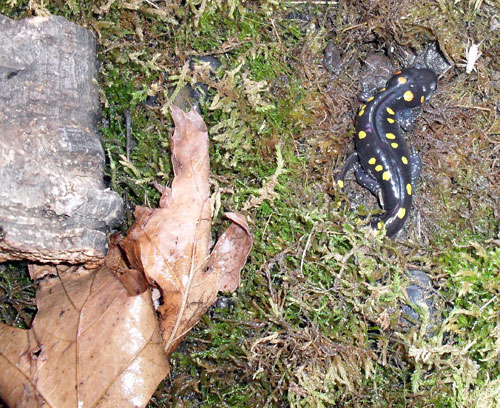
An example of a moss substrate. Photo: Johnny Farnen, 2009.
Compaction
Compaction of the soil is an issue for species that actively burrow; if the soil compacts nicely, it will hold its shape for tunnels. Use of a substrate that compacts well, without becoming an impenetrable solid is key for tunneling caudates. Coir works fairly well, however soil substrates are generally best for this application. A mixture of soil, leaf litter, and coir works very well. Many keepers add a handful of sand to the mix to help prevent clumping.
A proper substrate with good compaction characteristics can be hard to make, but a bit of experimentation can go a long way. To test your burrowing substrate, compress a sample into an empty margarine container. Let it sit over night. The next day, flip the container over on a sheet of paper. If the substrate holds the shape of the container without crumbling, yet easily allows penetration with a pencil, you have a good mix.
Commercial clays and soils designed for burrowing reptiles, such as ZooMed Excavator Clay, are not suitable for caudates. These products generally have a high pH and hygroscopic properties. They also pose a serious digestive impaction risk in caudates.
Creation of subterranean hides and tunnels with PVC pipe eliminates the need for a properly compacting substrate. When halved lengthwise and installed along the glass, this method has the added benefit of allowing observation of the specimen's behavior underground.
Terrestrial Substrate Maintenance
Proper maintenance of terrestrial substrates is relatively simple. Spot clean it daily to remove dead feeder animals, wastes, and dead plants. Check the moisture content daily. Water any live plants weekly. Your sense of smell is your greatest tool here. A healthy vivarium should smell clean and fresh. If it smells sour or swampy, you need to do a substrate change and pay more careful attention to cleaning and moisture content.
Keep in mind that vivaria are not potted plants or terrariums. A complete replacement of the substrate should be planned for. For soil-like substrates, they will typically need to be changed at intervals of 2-12 months. There are several factors to consider in deciding how often to change the substrate. The size of the enclosure, depth of the substrate, and moisture levels all work in conjunction with the number and size of the animals. It is wisest to use your own judgment. The texture of the substrate often gives a clue, particularly if you are using coir or leaf litter; if the material has become dense and compact, it's time to replace it. If the enclosure looks or smells like it needs a change, it probably does!
Related Forum Threads
Personal preferences for types of terrestrial substrates:
http://www.caudata.org/forum/showthread.php?t=62596
Substrate pH issues:
http://www.caudata.org/forum/showthread.php?t=64153
Substrate pH issues:
http://www.caudata.org/forum/showthread.php?t=35450
Substrate pH issues:
http://www.caudata.org/forum/showthread.php?t=34582
Substrate pH issues:
http://www.caudata.org/forum/showthread.php?t=35450
Use of cypress mulch:
http://www.caudata.org/forum/showthread.php?t=37319
Drainage layers, and the use of charcoal in vivariums:
http://www.frogforum.net/tree-frogs/823-drainage-layer.html
Personal preferences for types of paper substrate:
http://www.caudata.org/forum/showthread.php?t=64499
References
Ballard, B. M. and R. Cheek, eds. Exotic Animal Medicine for the Veterinary Technician. Wiley-Blackwell Publishing: 2003.
Bartlett, R. D. and P. Bartlett. Terrarium and Cage Construction and Care. Barron's: 1999.
Feder, M. E. and W. W. Burggren, eds. Environmental Physiology of the Amphibians. University Of Chicago Press, 1st edition: October 1992.
Hatch, A.C., L.K. Belden, E. Scheessele and A.R. Blaustein. Juvenile amphibians do not avoid potentially lethal levels of urea on soil substrate. Environmental Toxicology and Chemistry, Vol. 20, No. 10, pp. 2328-2335, 2001.
Mitchell, M. and T. Tully. Manual of Exotic Pet Practice. Elsevier Health Sciences; 2008.
O'Reilly, J., Fenolio, D. and Ready, M. 1995. Limbless Amphibians: Caecilians. Vivarium, 7(1):26-54.
Pough, F. H. Recommendations for the Care of Amphibians and Reptiles in Academic Institutions. National Academy Press, Washington, D.C., 1992. Accessed Oct. 20, 2009.
http://netvet.wustl.edu/species/reptiles/pough.txt
Searcey, R. L. A Little Shoreline Vivarium. Reptiles Magazine, Oct 2001: 42-47.
Searcey, R. L. Vivarium Planting Mixes: Part I - Basic Information and Components. Reptiles Magazine, Dec 2001: 40-47.
Searcey, R. L. Vivarium Planting Mixes: Part 2 - Recipes & Sources. Reptiles Magazine, Mar 2002.
Searcey, R. L. Flourish over Failure. Reptiles USA, 2009 Annual.
Sugalski, M. T. and D. L. Claussen. 1997. Preference for soil moisture, soil pH, and light intensity by the salamander, Plethodon cinereus. Journal of Herpetology. 31 (2):245-250
Wells, K. D. The Ecology and Behavior of Amphibians. University of Chicago Press: 2007.
Wright, K. and B. Whittaker. Amphibian Medicine and Captive Husbandry. Krieger Publishing: 2001.
© 2009 Johnny O. Farnen
